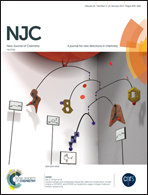Novel electroluminescent donor–acceptors based on dibenzo[a,c]phenazine as hole-transporting materials for organic electronics†
Abstract
A series of novel donor–acceptor type of molecules (2–6) based on dibenzo[a,c]phenazine were synthesized by employing a palladium = catalyzed C–N bond forming amination reaction in a good yield and were then fully characterized, whereby the optical properties of 2–6 were determined by UV-vis absorption, fluorescence spectroscopy, and the electrochemical properties by cyclic voltammetry. The absorption spectra of 2–6 showed intramolecular charge transfer (ICT) transitions in the range of 447–513 nm in solution. The HOMO and LUMO energy levels of 2–6 were in the range from −5.03 to −5.29 eV and −2.75 to −2.87 eV, respectively, with an electrochemical band gap within 2.26–2.45 eV. The HOMO energy levels of 2–6 are comparable with those of the most commonly used hole-transporting materials, which makes them potential candidates for hole-transporting materials in organic electronics.
![Graphical abstract: Novel electroluminescent donor–acceptors based on dibenzo[a,c]phenazine as hole-transporting materials for organic electronics](/en/Image/Get?imageInfo.ImageType=GA&imageInfo.ImageIdentifier.ManuscriptID=C6NJ03553A&imageInfo.ImageIdentifier.Year=2017)

 Please wait while we load your content...
Please wait while we load your content...